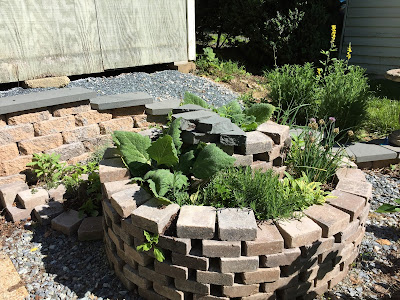Those of you who follow my other garden writing will know that the Grow It Eat It blog ceased publication recently (it's still archived online) and was absorbed into a new blog called
Maryland Grows which I am not running, hurray. I am writing for the new blog once a month, but my old habit of jotting down any thoughts I had about food gardening at Grow It Eat It is now curtailed, so you'll probably see more notes on edibles here as well as GBBD and landscaping progress.
I do tend to forget to keep notes on things like which tomato varieties are worth growing again, so here I am amending that. Right now I am kind of drowning in tomatoes. It's great to have plenty for fresh eating plus many bags of roasted ones in the freezer, but it's a bit overwhelming considering that we are going away again soon. I started using Texas Tomato Cages this year (they are great!) and the other day I told my husband I'd order six more of them for next year and just grow twelve tomato plants, and he said "How about six?" and you know, he might be right, although ha ha I don't think that will happen.
Anyway, I would call this year's tomato planting a success, on the whole. Last year I had tomatoes on the edges of my community garden plot, and one row did beautifully and the other (along the grassy edge) was spindly and awful. I decided this was due to soil issues, and have put in raised beds along that edge, and in fact some of the varieties that did poorly there last year are fine this year in the middle of the plot, so I really do think it was soil, either compaction or just poor composition or insufficient nutrients.
I've been trying to take photos before I devour, so here are some of the types I've grown this year, starting with the monsters.
That's a quarter in there for size comparison! On the top is an unnamed variety that a MG friend collected seed from in France. I haven't tasted it yet (they've only just started ripening) but she's been growing it for 15 years which is a good recommendation. Oddly, though she's had great consistency in fruit type all that time, this year she had one cherry tomato pop up in the mix, and of the two plants I grew from her seed, one of them is also a cherry. It's a good and prolific cherry, but not expected.
The odd-shaped red one is Brandywine Sudduth's Strain, and the yellow one is Golden King of Siberia, which is one of those that did terribly last year in the bad soil, so I'm glad I gave it another try. It's produced a lot of fruit that is delicious, well-shaped and evenly-ripened.
That's another somewhat smaller Golden King on the lower left; above is Chef's Choice Orange, a hybrid that's pumping out perfectly round orange fruit that tastes pretty good too. The yellow pear-shaped tomatoes are Old Ivory Egg, which I like though it tends to have a hard center. The small one with the nipple is Tsitrusovyy Sad, a Russian/Ukrainian heirloom that hasn't grabbed me that much, though it's pretty.
And hurray, I have a successful Aunt Ruby's German Green:
which is one of my favorite eating tomatoes ever, but in my experience hard to get a lot of fruit out of. The plant is grafted (I did the grafting myself, yay me) and is very vigorous with good production. (By the way, I heard Craig LeHoullier say in a lecture that Aunt Ruby wasn't German at all; that just made the name sound better. Whatever; it tastes great.)
Other successes: the consistent and rich-flavored Rose de Berne (medium-sized slicer, center top in below photo), and the striped cherry tomato Pink Bumblebee. I also planted Red Fig, a little pear-shaped over-achiever, which has at least enhanced the volume of roasted tomatoes I'm freezing.
Not so great, Chocolate Stripes, which is center in this photo:
It's not awful or anything, but in my experience the "chocolate" bits are actually russeting (or whatever you call the hard brown skin flaws in tomatoes) that has to be cut out, and there's a lot of it. I gave it another chance (it was in the Bad Soil Row last year) and now I am going to say goodbye.
Rosso Sicilian is in the upper right in the photo (not quite ripe). It's visually interesting and would make a good stuffing tomato, I think (haven't gotten around to doing that yet), but is pretty boring in flavor. Center bottom is Paul Robeson, which I have grown before and love; unfortunately this year's plant got attacked badly by early blight and then shaded out by its neighbors, so it is now dead. But I did get some good fruit from it.
I've got a couple others in the mix (Amish Red Oxheart, and another Ukrainian tomato I'm not bothering to remember right now) but I think the seed from those as well as the disappointments above will be tossed or passed on in a swap--someone else might do better with it, after all. Tomato preferences are highly subjective!





















































